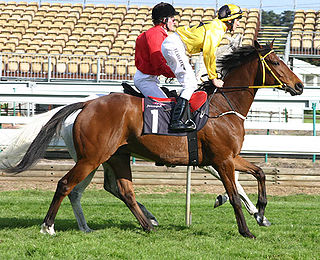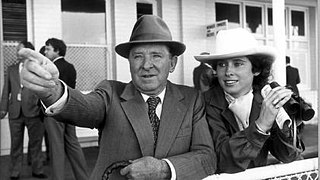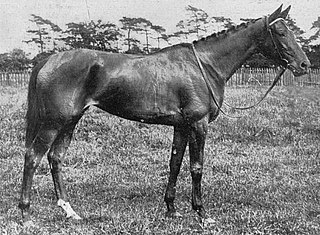
The W.S. Cox Plate is a Moonee Valley Racing Club Group 1 Thoroughbred horse race for horses aged three years old and over under Weight for age conditions, over a distance of 2040 metres, held at Moonee Valley Racecourse, Melbourne, Australia in late October. The race is Australia's richest weight-for-age race with stakemoney of A$5,000,000.

Northerly was an Australian racehorse who is considered arguably Australia's best middle distance Thoroughbred horse of the early 2000s. Northerly, trained by Western Australian harness racing legend Fred Kersley, won nine Group One (G1) races, including the Australian Cup twice, and the Cox Plate, regarded as the Weight for Age championship of Australasia, also on two occasions.
Savabeel is a retired Australian Thoroughbred race horse and active sire. He is best known for his win in the 2004 Cox Plate.
Sunline (1995–2009) was a New Zealand-bred Thoroughbred racehorse who was the world's highest earning racemare of her time, competing on 48 occasions for 32 wins, 9 seconds and 3 thirds to earn A$11,351,607. She won races in three different countries, Australia, New Zealand and Hong Kong. She won successive W.S. Cox Plates (2,040m), the richest Weight for Age (WFA) race in Australia. She also twice won the toughest mile race in Australia, the Doncaster Handicap, once as a three-year-old and then again as a six-year-old. She was named New Zealand Horse of the Year four times and is also the first of only 3 horses ever to win the Australian Horse of the Year championship three times, the others being Black Caviar and Winx. The only horse besides Sunline to win as many major races in both Australia and New Zealand was Gloaming, who raced around 1915.

Desert Gold was a famous and successful New Zealand Thoroughbred racehorse who raced at the time of World War I. She raced in Australia and New Zealand, winning 36 races, including 19 in succession.

Thomas John Smith also known as Tommy Smith or T. J. Smith was a leading trainer of thoroughbred racehorses based in Sydney, Australia.

Ajax was a champion Australian bred Thoroughbred racehorse and sire, who won 18 consecutive races before he was defeated at the odds of 40/1 on, causing a huge racing sensation. He had wins from 5 furlongs (1,000 metres) to 1½ miles (2,400 metres), equalled the Australasian record for a mile (1,600 metres), and created three new race records. At stud in Australia, Ajax proved to be a good sire. He was then sold as a 14-year-old horse and exported to the United States before he was later sold to Bing Crosby and Lin Howard. Ajax was inducted into the Australian Racing Hall of Fame in 2004.

Nightmarch, foaled in 1925 was an outstanding New Zealand bred Thoroughbred racehorse known as The Kiwi. He won the New Zealand Derby and Dunedin Cup as a three-year-old before going to Australia where he became the first horse to win both the Melbourne Cup and Cox Plate in the same year, as well as other Principal races.
Let's Elope was a Champion Thoroughbred racehorse in Australia.
Leilani was a champion thoroughbred racemare that was bred in New Zealand and raced in Australia. She won six Group One races and a total of 12 black type equivalent races, during her short racing career. At the time of her retirement she held the Australasian earnings record for a mare.
Flaming Page was a Canadian Thoroughbred who was a Champion racehorse and then an outstanding broodmare. She is best known as the dam of English Triple Crown winner Nijinsky. She was elected to the Canadian Horse Racing Hall of Fame in 1980.

Briseis foaled in 1873, was a brown Australian Thoroughbred filly that is regarded as one of the greatest mares ever foaled in Australia. As a two-year-old she won the AJC Doncaster Handicap and the weight for age (w.f.a.) AJC All Aged Stakes. Then as a three-year-old she won the VRC Victoria Derby, the Melbourne Cup and the VRC Oaks, all within six days.

Tranquil Star was one of the hardiest and best performed Australian-bred Thoroughbred race-mares. She is the only mare to have won the double of the Caulfield Stakes, now known as the Yalumba Stakes, and the Cox Plate, which is the most prestigious weight-for-age (wfa) race in Australia. Tranquil Star had 111 starts and won over distances ranging from 5 furlongs to 14 furlongs. She was later inducted into the Australian Racing Hall of Fame.

Dunfermline (1974–1989), was a British Thoroughbred racehorse and Broodmare. In a career which lasted from July 1976 until August 1978, she ran twelve times and won three races. In 1977, the year of her owner, Queen Elizabeth II's Silver Jubilee, she won two of the five British Classic Races. She won The Oaks against other fillies in June and in September added St. Leger Stakes, beating the double Prix de l'Arc de Triomphe winner Alleged. She raced without winning in 1978 before she was retired to stud.
Flying Water was a French Thoroughbred racehorse. In a racing career which was disrupted by injury, she ran eleven times and won six races between July 1975 and June 1978. After winning her only race as a two-year-old, she won the Classic 1000 Guineas at Newmarket Racecourse in the spring of 1977. Having missed the second half of her three-year-old season through injury, she returned in 1978. She defeated leading sprinters in the Prix Maurice de Gheest, mile specialists in the Prix Jacques le Marois, and middle-distances horses in the Champion Stakes. In 1978, she was sent to race in the United States where she was killed in an accident in a race at Belmont Park on 25 June.
Atlantic Jewel is an Australian Thoroughbred racehorse. Sired by champion sire Fastnet Rock, and raced by Coolmore, Atlantic Jewel was trained by Melbourne's Mark Kavanagh. She has currently won nine of her ten starts, including three Group One races. Her dominant victory at her eighth start in the Memsie Stakes, after a long injury break, confirmed her standing as Australia's best racehorse.

Winx is a retired champion Australian Thoroughbred racehorse. Between May 2015 and her retirement in April 2019, she won 33 consecutive races including 25 Group 1s, at distances ranging from 1300 metres to 2200 metres. In the World's Best Racehorse Rankings, she was the second-ranked filly or mare in 2015, improving in 2016 to become both the world's top-ranked filly or mare and the world's top-ranked turf horse. She retained this ranking in 2017 and in 2018 was co-ranked as the best horse in the world. In 2017 she was inducted into the Australian Racing Hall of Fame, only the third horse to earn this honour while still in training. She is the leading money-earner in history.

Pogrom was a British Thoroughbred racehorse and broodmare. As a two-year-old in 1921 she showed considerable promise by winning four of her six starts. In the following year she was one of the best fillies of her generation as she won the Epsom Oaks, Coronation Stakes and Newmarket Oaks and finished second on three other occasions. She made very little impact as a broodmare and died in 1933.

My Dear was a British Thoroughbred racehorse and broodmare. In 1917 she showed top-class form, winning both her races including the prestigious Dewhurst Stakes. In the following year she finished second in the 1000 Guineas and was then awarded the New Oak Stakes on the disqualification of Stony Ford. She went on to win the Champion Stakes, Lowther Stakes and Liverpool Autumn Cup as well as finishing second in the wartime substitute St Leger. She was not a great success as a broodmare but did produce at least two winners before her death in 1933.

Rhodora was an Irish Thoroughbred racehorse and broodmare. She was one of the best juvenile fillies in the British Isles in 1907 when she won three of her six races including a victory over strong male opposition in the Dewhurst Stakes. In the following year she won the 1000 Guineas but was brought down when favourite for the Epsom Oaks. She won two more races in Ireland before her racing career was ended by injury. She was retired from racing to become a broodmare, but none of her produce survived long after birth.















